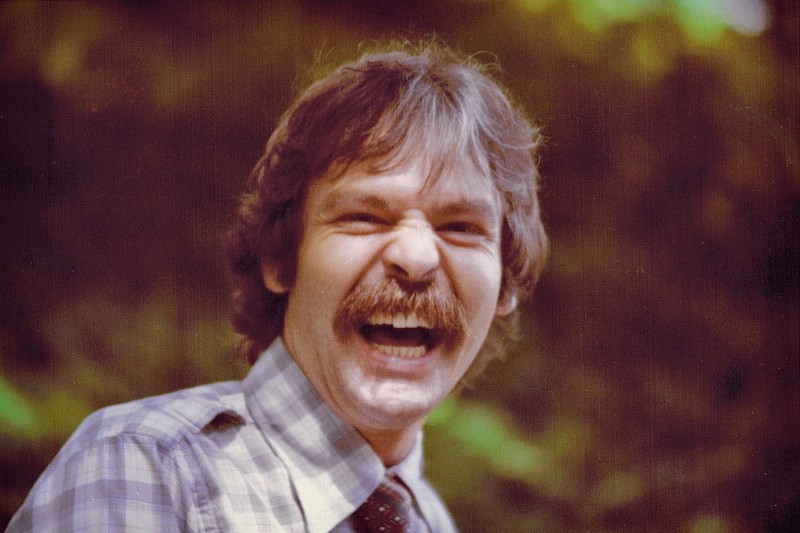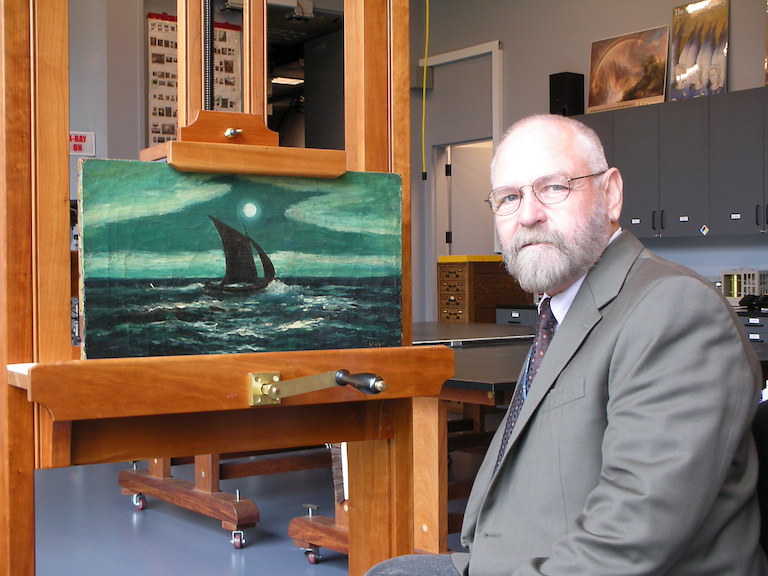
Category: Art Conservation
In Memoriam: Carl Grimm (1946-2025)
February 03, 2025 Written by CTricia O’Regan and Joyce Hill Stoner
Emmett Carl Grimm (WUDPAC ‘78, ACR/PSP ‘99) was born in Harrisonburg, Virginia in 1946 and died on January 25, 2025, in San Francisco, after a long illness. “Carl” attended the College of William and Mary, earned a BS in Life Sciences and Chemistry in 1970, and carried out additional coursework in European Art History and Painting, also at William and Mary. Joyce Hill Stoner (William and Mary ‘68) recalls that Tom Thorne, the professor of painting at William and Mary, told her that Carl was one of the most talented paintings students he had ever had. A gifted painter who has been pre-med? He had to become a paintings conservator! After a short stint in the Park Service, he learned about conservation through his college friend, Joyce.
Carl interned in paintings conservation with Charles Olin in Great Falls, Virginia, for more than two years in the early 1970s. David Olin notes: “I know my father Charles viewed Carl as one of, if not his most, cherished students and colleagues. This respect began when Carl assisted Charles in setting up the private lab. I remember Carl fondly. My specific recollections of him during this time are less relevant to conservation and more to Carl's persona - his sense of humor, his being somewhat intimidating to a youngster, his ginormous mustache, and his caring for his (at the time baby) Jeremy. I recall that Carl was always a kind, positive and caring person to whom I was easily able to reach out as the years progressed. He spent part of a summer working with us again in the '90s - I can see him now, inpainting, shirtless, seated before an easel in the sun on the roof deck of our studio.”

Carl was accepted in the second class of the Winterthur/University of Delaware Program in Art Conservation in 1975 and graduated with an MS degree in 1978. It was prophetic that he carried out his third-year internship in San Francisco where he spent the most extended phase of his career. He interned at the San Francisco Museum of Modern Art, studying with lab Co-directors James Bernstein and Inge- Lise Eckmann.
From 1978-1981 he was the Chief Paintings Conservator for the Rocky Mountain Regional Conservation at the University of Denver. He created a state-of-the-art paintings conservation facility in an empty university building with funding from the Mellon Foundation and the NEA. Next, he served as the Director and Chief Paintings Conservator for the Western Center for the Conservation of Fine Arts in Denver (1981 to 1988), supervising a staff of eight. Carmen Bria eventually took over the WCCFA, and wrote: “I consider Carl my mentor, an inspiring business partner, a valued colleague, and my friend. I probably owe my conservation career to him! Carl was smart and driven. He was a caring and generous professional towards those he trained and worked beside, and in his relationships. He taught me a lot about conservation and life.”
He moved further west and was a guest scholar in painting conservation at the J. Paul Getty Museum. In 1989 he worked on Giulio Romano’s Birth of Bacchus for an upcoming Romano retrospective in Mantua. What next? He moved to Munich, restored paintings from the Alte Pinakothek and became fluent in German.

Dr. Stoner was especially pleased to welcome him back to the University of Delaware as one of the first PhD students in the new Art Conservation Research doctoral program. He was a funded fellow from 1990 to 1993, working with esteemed Ryder scholar Dr. William Homer, consulting a collection of Ryder forgeries given to UD by Lloyd Goodrich and traveling to see fully documented Ryders. He returned to San Francisco in 1993, but continued work on his doctorate and finished in 1999. Drs. Stoner and Homer were both extremely impressed with Carl’s dissertation A Study of Authenticity in Paintings Attributed to Albert Pinkham Ryder. Dr. Stoner notes that anyone studying Ryder must consult this work: “Albert Pinkham Ryder is one of the most forged American artists of all time. Carl Grimm’s dissertation constructed a systematic interdisciplinary approach combining procedures used in both art history and scientific analysis to discriminate between authentic and inauthentic works by Ryder. For each painting to be considered, he demonstrated what should be the expected characteristics with regard to provenance and history, subject matter, design, technique, color harmonies, physical structure, facture and patina, x-radiographic image, interlayer structure through cross-sectional analysis of paint samples, media diversity, and pigment analysis. It was a remarkable synthesis of art history, scientific analysis, and a true understanding of paintings and their appearance and materials.”
From 1993 until 2012, he served as the Head Painting Conservator at the Fine Arts Museum of San Francisco. Again, Carl's entrepreneurial and creative instincts helped him as he grew the department from one to four positions before retiring. Colleague Tricia O'Regan writes: "I had met Carl when we were both working in the studio at Winterthur. He offered me a job in 1994 as he knew I wished to move home. After I started, it became very apparent to me that the museum had approved no real job. In fact, he had been told by the director that he would never have a staff. He basically willed our department into being. As I am still here at FAMSF 30 years later, it is a testament to his faith in his vision. The training I received under Carl and Tony Rockwell made me a conservator. He was a most generous mentor and a good friend. He was always up for arguing over treatments and welcomed all working styles. Carl could be very serious but also silly and a tad subversive. I was so lucky to work and learn from him. He loved teaching and having as many interns around as we could fit. We have fond memories of his hosting many parties at his San Francisco flat and a wonderful overnight trip a bunch of us took ‘up country’ to his grand Mendocino spread.”
Carl loved his friends; he loved being a conservator, and he was loved by many. He leaves behind his son Jeremy, Jeremy’s wife, and a granddaughter, with whom Carl was smitten; his former wife, Mary Ellen Newman Grimm, and his great friends worldwide. His partner, Michael Pladeck, of Berlin, predeceased him.
—by Tricia O’Regan and Joyce Hill Stoner, with contributions from Jim Bernstein, Carmen Bria, and David Olin
